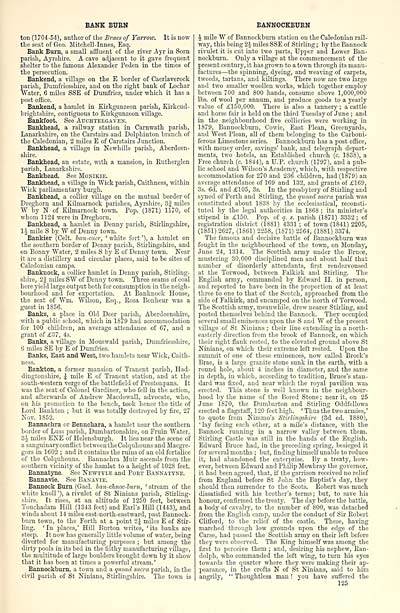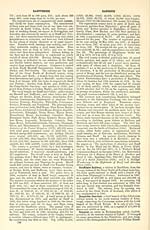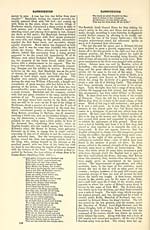Ordnance gazetteer of Scotland > Volume 1
(161) Page 125
Download files
Complete book:
Individual page:
Thumbnail gallery: Grid view | List view

BANK BURN
ton (1704-54), author of the Braes of Yarrow. It is now
the seat of Geo. Mitchell-Innes, Esq.
Bank Burn, a small affluent of the river Ayr in Sorn
parish, Ayrshire. A cave adjacent to it gave frequent
shelter to the famous Alexander Peden in the times of
the persecution.
Bankend, a village on the E horder of Caerlaverock
parish, Dumfriesshire, and on the right bank of Lochar
Water, 6 miles SSE of Dumfries, under which it has a
post office.
Bankend, a hamlet in Kirkgunzeon parish, Kirkcud-
brightshire, contiguous to Kirkgunzeon village.
Bankfoot. See Auchteegaven.
Bankhead, a railway station in Carnwath parish,
Lanarkshire, on the Carstairs and Dolphinton branch of
the Caledonian, 2 miles E of Carstairs Junction.
Bankhead, a village in Newhills parish, Aberdeen-
shire.
Bankhead, an estate, with a mansion, in Rutherglen
parish, Lanarkshire.
Bankhead. See Monikie.
Bankhead, a village in Wick parish, Caithness, within
"Wick parliamentary burgh.
Bankhead, a collier village on the mutual border of
Dreghorn and Kilmarnock parishes, Ayrshire, 3f miles
W by N of Kilmarnock town. Pop. (1871) 1170, of
whom 1124 were in Dreghorn.
Bankhead, a hamlet in Denny parish, Stirlingshire,
1 J,- mile S by W of Denny town.
Bankier (Celt, lan-cacr, ' white fort '), a hamlet on
the southern border of Denny parish, Stirlingshire, and
on Bonny Water, 2 miles S by E of Denny town. Near
it are a distillery and circular places, said to be sites of
Caledonian camps.
Banknock, a collier hamlet in Denny parish, Stirling-
shire, 2 1 miles SW of Denny town. Three seams of coal
here yield large output both for consumption in the neigh-
bourhood and for exportation. At Banknock House,
the seat of Wm. Wilson, Esq., Kosa Bonheur was a
guest in 1856.
Banks, a place in Old Deer parish, Aberdeenshire,
with a public school, which in 1879 had accommodation
for 100 children, an average attendance of 67, and a
grant of £37, 4s.
Banks, a village in Mouswald parish, Dumfriesshire,
6 miles SE by E of Dumfries.
Banks, East and West, two hamlets near Wick, Caith-
ness.
Bankton, a former mansion of Tranent parish, Had-
dingtonshire, J mile E of Tranent station, and at the
south-western verge of the battlefield of Prestonpans. It
was the seat of Colonel Gardiner, who fell in the action,
and afterwards of Andrew Macdowall, advocate, who,
on his promotion to the bench, took hence the title of
Lord Bankton ; but it was totally destroyed by fire, 27
Nov. 1852.
Bannachra or Benuchara, a hamlet near the southern
border of Luss parish, Dumbartonshire, on Fruin Water,
3J miles ENE of Helensburgh. It lies near the scene of
a sanguinary conflict between the Colquhouns and Macgre-
gors in 1602 ; and it contains the ruins of an old fortalice
of the Colquhouns. Bannachra Muir ascends from the
southern vicinity of the hamlet to a height of 1028 feet.
Bannatyne. See Newtyle and Port Bannatyne.
Bannavie. See Banavie.
Bannock Burn (Gael, ban-chnoc-burn, ' stream of the
white knoll '), a rivulet of St Ninians parish, Stirling-
shire. It rises, at an altitude of 1250 feet, between
Touchadam Hill (1343 feet) and Earl's Hill (1443), and
winds about 14 miles east-north-eastward, past Bannock-
burn town, to the Forth at a point 2J miles E of Stir-
ling. 'In places,' Hill Burton writes, 'its banks are
steep. It now has generally little volume of water, being
diverted for manufacturing purposes ; but among the
dirty pools in its bed in the filthy manufacturing village,
the multitude of large boulders brought down by it show
that it has been at times a powerful stream.'
Bannockburn, a town and a quoad sacra parish, in the
civil parish of St Ninians, Stirlingshire. The town is
BANNOCKBURN
J mile W of Bannockburn station on the Caledonian rail-
way, this being 2i miles SSE of Stirling ; by the Bannock
rivulet it is cut into two parts, Upper and Lower Ban-
nockburn. Only a village at the commencement of the
present century, it has grown to a town through its manu-
factures — the spinning, dyeing, and weaving of carpets,
tweeds, tartans, and kiltings. There now are two large
and two smaller woollen works, which together employ
between 700 and 800 hands, consume above 1,000,000
lbs. of wool per annum, and produce goods to a yearly
value of £150,000. There is also a tannery; a cattle
and horse fair is held on the third Tuesday of June ; and
in the neighbourhood five collieries were working in
1879, Bannockburn, Cowie, East Plean, Greenyards,
and West Plean, all of them belonging to the Carboni-
ferous Limestone series. Bannockburn has a post office,
with money order, savings' bank, and telegraph depart-
ments, two hotels, an Established church (c. 1838), a
Free church (e. 1844), a U.P. church (1797), and a pub-
lic school and Wilson's Academy, which, with respective
accommodation for 270 and 236 children, had (1879) an
average attendance of 169 and 132, and grants of £169,
3s. 6d. and £105, 3s. In the presbytery of Stirling and
synod of Perth and Stirling, the quoad sacra parish was
constituted about 1838 by the ecclesiastical, reconsti-
tuted by the legal authorities in 186S ; its minister's
stipend is £150. Pop. of q. s. parish (1871) 3332 ; of
registration district (1881) 4331 ; of town (1841) 2205,
(1851) 2627, (1861) 2258, (1871) 2564, (1881) 3374.
The famous and decisive battle of Bannockburn was
fought in the neighbourhood of the town, on Monday,
June 24, 1314. The Scottish army under the Bruce,
mustering 30,000 disciplined men and about half that
number of disorderly attendants, first rendezvoused
at the Torwood, between Falkirk and Stirling. The
English army, commanded by Edward II. in person,
and reported to have been in the proportion of at least
three to one to that of the Scotch, approached from the
side of Falkirk, and encamped on the north of Torwood.
The Scottish army, meanwhile, drew nearer Stirling, and
posted themselves behind the Bannock. They occupied
several small eminences upon the S and W of the present
village of St Ninians ; their line extending in a north-
easterly direction from the brook of Bannock, on which
their right flank rested, to the elevated ground above St
Ninians, on which their extreme left rested. Upon the
summit of one of these eminences, now called Brock's
Brae, is a large granite stone sunk in the earth, with a
round hole, about 4 inches in diameter, and the same
in depth, in which, according to tradition, Bruce's stan-
dard was fixed, and near which the royal pavilion was
erected. This stone is well known in the neighbour-
hood by the name of the Bored Stone ; near it, on 25
June 1870, the Dumbarton and Stirling Oddfellows
erected a flagstaff, 120 feet high. ' Thus the two armies,'
to quote from Nimmo's Stirlingshire (3d ed. 1880),
'lay facing each other, at a mile's distance, with the
Bannock running in a narrow valley between them.
Stirling Castle was still in the hands of the English.
Edward Bruce had, in the preceding spring, besieged it
for several months ; but, finding himself unable to reduce
it, had abandoned the enterprise. By a treaty, how-
ever, between Edward and Philip Mowbray the governor,
it had been agreed, that, if the garrison received no relief
from England before St John the Baptist's day, they
should then surrender to the Scots. Robert was much
dissatisfied with his brother's terms; but, to save his
honour, confirmed the treaty. The day before the battle,
a body of cavalry, to the number of 800, was detached
from the English camp, under the conduct of Sir Robert
Clifford, to the relief of the castle. These, having
marched through low grounds upon the edge of the
Carse, had passed the Scottish army on their left before
they were observed. The King himself was among the
first to perceive them ; and, desiring his nephew, Ran-
dolph, who commanded the left wing, to turn his eyes
towards the quarter where they were making their ap-
pearance, in the crofts N of St Ninians, said to him
angrily, ' ' Thoughtless man ! you have suffered the
125
ton (1704-54), author of the Braes of Yarrow. It is now
the seat of Geo. Mitchell-Innes, Esq.
Bank Burn, a small affluent of the river Ayr in Sorn
parish, Ayrshire. A cave adjacent to it gave frequent
shelter to the famous Alexander Peden in the times of
the persecution.
Bankend, a village on the E horder of Caerlaverock
parish, Dumfriesshire, and on the right bank of Lochar
Water, 6 miles SSE of Dumfries, under which it has a
post office.
Bankend, a hamlet in Kirkgunzeon parish, Kirkcud-
brightshire, contiguous to Kirkgunzeon village.
Bankfoot. See Auchteegaven.
Bankhead, a railway station in Carnwath parish,
Lanarkshire, on the Carstairs and Dolphinton branch of
the Caledonian, 2 miles E of Carstairs Junction.
Bankhead, a village in Newhills parish, Aberdeen-
shire.
Bankhead, an estate, with a mansion, in Rutherglen
parish, Lanarkshire.
Bankhead. See Monikie.
Bankhead, a village in Wick parish, Caithness, within
"Wick parliamentary burgh.
Bankhead, a collier village on the mutual border of
Dreghorn and Kilmarnock parishes, Ayrshire, 3f miles
W by N of Kilmarnock town. Pop. (1871) 1170, of
whom 1124 were in Dreghorn.
Bankhead, a hamlet in Denny parish, Stirlingshire,
1 J,- mile S by W of Denny town.
Bankier (Celt, lan-cacr, ' white fort '), a hamlet on
the southern border of Denny parish, Stirlingshire, and
on Bonny Water, 2 miles S by E of Denny town. Near
it are a distillery and circular places, said to be sites of
Caledonian camps.
Banknock, a collier hamlet in Denny parish, Stirling-
shire, 2 1 miles SW of Denny town. Three seams of coal
here yield large output both for consumption in the neigh-
bourhood and for exportation. At Banknock House,
the seat of Wm. Wilson, Esq., Kosa Bonheur was a
guest in 1856.
Banks, a place in Old Deer parish, Aberdeenshire,
with a public school, which in 1879 had accommodation
for 100 children, an average attendance of 67, and a
grant of £37, 4s.
Banks, a village in Mouswald parish, Dumfriesshire,
6 miles SE by E of Dumfries.
Banks, East and West, two hamlets near Wick, Caith-
ness.
Bankton, a former mansion of Tranent parish, Had-
dingtonshire, J mile E of Tranent station, and at the
south-western verge of the battlefield of Prestonpans. It
was the seat of Colonel Gardiner, who fell in the action,
and afterwards of Andrew Macdowall, advocate, who,
on his promotion to the bench, took hence the title of
Lord Bankton ; but it was totally destroyed by fire, 27
Nov. 1852.
Bannachra or Benuchara, a hamlet near the southern
border of Luss parish, Dumbartonshire, on Fruin Water,
3J miles ENE of Helensburgh. It lies near the scene of
a sanguinary conflict between the Colquhouns and Macgre-
gors in 1602 ; and it contains the ruins of an old fortalice
of the Colquhouns. Bannachra Muir ascends from the
southern vicinity of the hamlet to a height of 1028 feet.
Bannatyne. See Newtyle and Port Bannatyne.
Bannavie. See Banavie.
Bannock Burn (Gael, ban-chnoc-burn, ' stream of the
white knoll '), a rivulet of St Ninians parish, Stirling-
shire. It rises, at an altitude of 1250 feet, between
Touchadam Hill (1343 feet) and Earl's Hill (1443), and
winds about 14 miles east-north-eastward, past Bannock-
burn town, to the Forth at a point 2J miles E of Stir-
ling. 'In places,' Hill Burton writes, 'its banks are
steep. It now has generally little volume of water, being
diverted for manufacturing purposes ; but among the
dirty pools in its bed in the filthy manufacturing village,
the multitude of large boulders brought down by it show
that it has been at times a powerful stream.'
Bannockburn, a town and a quoad sacra parish, in the
civil parish of St Ninians, Stirlingshire. The town is
BANNOCKBURN
J mile W of Bannockburn station on the Caledonian rail-
way, this being 2i miles SSE of Stirling ; by the Bannock
rivulet it is cut into two parts, Upper and Lower Ban-
nockburn. Only a village at the commencement of the
present century, it has grown to a town through its manu-
factures — the spinning, dyeing, and weaving of carpets,
tweeds, tartans, and kiltings. There now are two large
and two smaller woollen works, which together employ
between 700 and 800 hands, consume above 1,000,000
lbs. of wool per annum, and produce goods to a yearly
value of £150,000. There is also a tannery; a cattle
and horse fair is held on the third Tuesday of June ; and
in the neighbourhood five collieries were working in
1879, Bannockburn, Cowie, East Plean, Greenyards,
and West Plean, all of them belonging to the Carboni-
ferous Limestone series. Bannockburn has a post office,
with money order, savings' bank, and telegraph depart-
ments, two hotels, an Established church (c. 1838), a
Free church (e. 1844), a U.P. church (1797), and a pub-
lic school and Wilson's Academy, which, with respective
accommodation for 270 and 236 children, had (1879) an
average attendance of 169 and 132, and grants of £169,
3s. 6d. and £105, 3s. In the presbytery of Stirling and
synod of Perth and Stirling, the quoad sacra parish was
constituted about 1838 by the ecclesiastical, reconsti-
tuted by the legal authorities in 186S ; its minister's
stipend is £150. Pop. of q. s. parish (1871) 3332 ; of
registration district (1881) 4331 ; of town (1841) 2205,
(1851) 2627, (1861) 2258, (1871) 2564, (1881) 3374.
The famous and decisive battle of Bannockburn was
fought in the neighbourhood of the town, on Monday,
June 24, 1314. The Scottish army under the Bruce,
mustering 30,000 disciplined men and about half that
number of disorderly attendants, first rendezvoused
at the Torwood, between Falkirk and Stirling. The
English army, commanded by Edward II. in person,
and reported to have been in the proportion of at least
three to one to that of the Scotch, approached from the
side of Falkirk, and encamped on the north of Torwood.
The Scottish army, meanwhile, drew nearer Stirling, and
posted themselves behind the Bannock. They occupied
several small eminences upon the S and W of the present
village of St Ninians ; their line extending in a north-
easterly direction from the brook of Bannock, on which
their right flank rested, to the elevated ground above St
Ninians, on which their extreme left rested. Upon the
summit of one of these eminences, now called Brock's
Brae, is a large granite stone sunk in the earth, with a
round hole, about 4 inches in diameter, and the same
in depth, in which, according to tradition, Bruce's stan-
dard was fixed, and near which the royal pavilion was
erected. This stone is well known in the neighbour-
hood by the name of the Bored Stone ; near it, on 25
June 1870, the Dumbarton and Stirling Oddfellows
erected a flagstaff, 120 feet high. ' Thus the two armies,'
to quote from Nimmo's Stirlingshire (3d ed. 1880),
'lay facing each other, at a mile's distance, with the
Bannock running in a narrow valley between them.
Stirling Castle was still in the hands of the English.
Edward Bruce had, in the preceding spring, besieged it
for several months ; but, finding himself unable to reduce
it, had abandoned the enterprise. By a treaty, how-
ever, between Edward and Philip Mowbray the governor,
it had been agreed, that, if the garrison received no relief
from England before St John the Baptist's day, they
should then surrender to the Scots. Robert was much
dissatisfied with his brother's terms; but, to save his
honour, confirmed the treaty. The day before the battle,
a body of cavalry, to the number of 800, was detached
from the English camp, under the conduct of Sir Robert
Clifford, to the relief of the castle. These, having
marched through low grounds upon the edge of the
Carse, had passed the Scottish army on their left before
they were observed. The King himself was among the
first to perceive them ; and, desiring his nephew, Ran-
dolph, who commanded the left wing, to turn his eyes
towards the quarter where they were making their ap-
pearance, in the crofts N of St Ninians, said to him
angrily, ' ' Thoughtless man ! you have suffered the
125
Set display mode to: Large image | Transcription
Images and transcriptions on this page, including medium image downloads, may be used under the Creative Commons Attribution 4.0 International Licence unless otherwise stated. ![]()
| Gazetteers of Scotland, 1803-1901 > Ordnance gazetteer of Scotland > Volume 1 > (161) Page 125 |
|---|
| Permanent URL | https://digital.nls.uk/97370698 |
|---|
| Attribution and copyright: |
|
|---|---|

